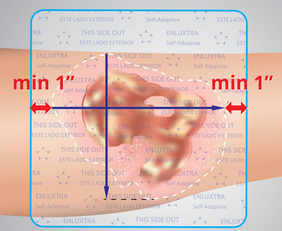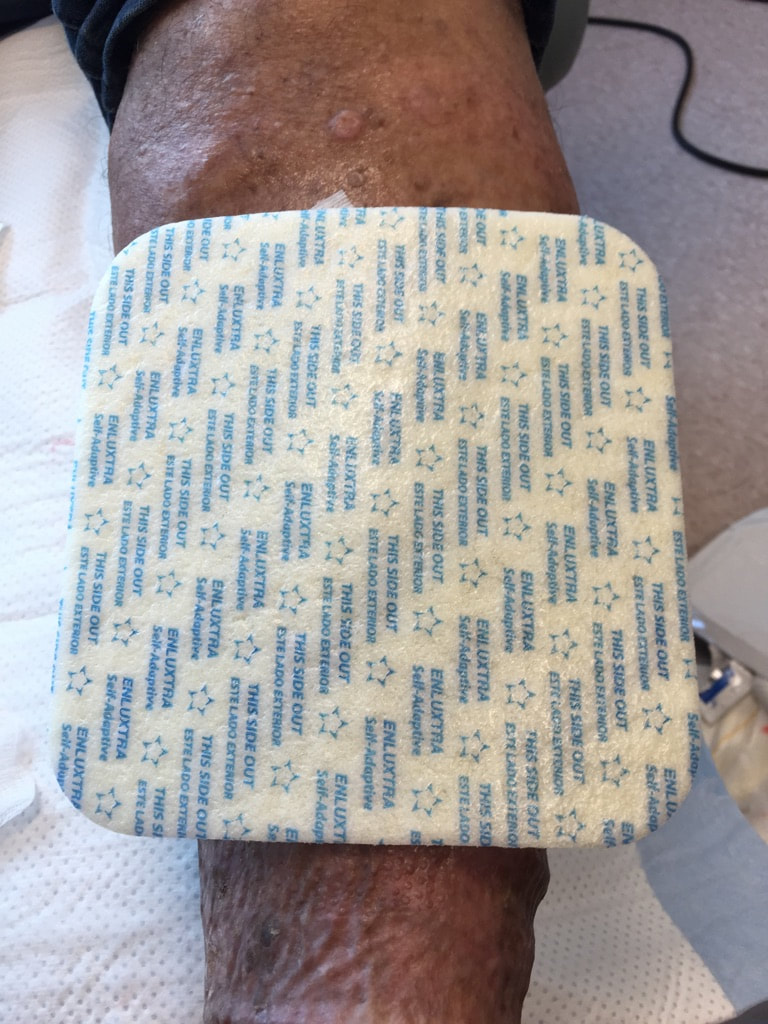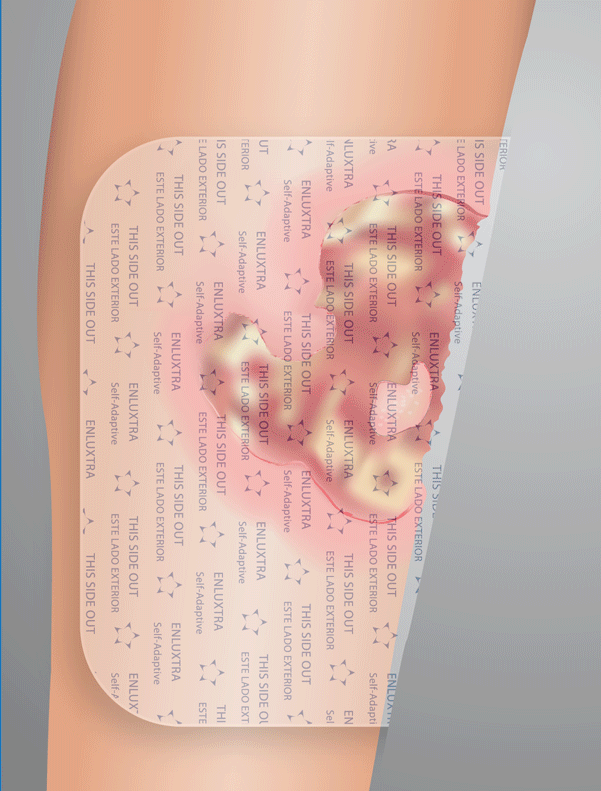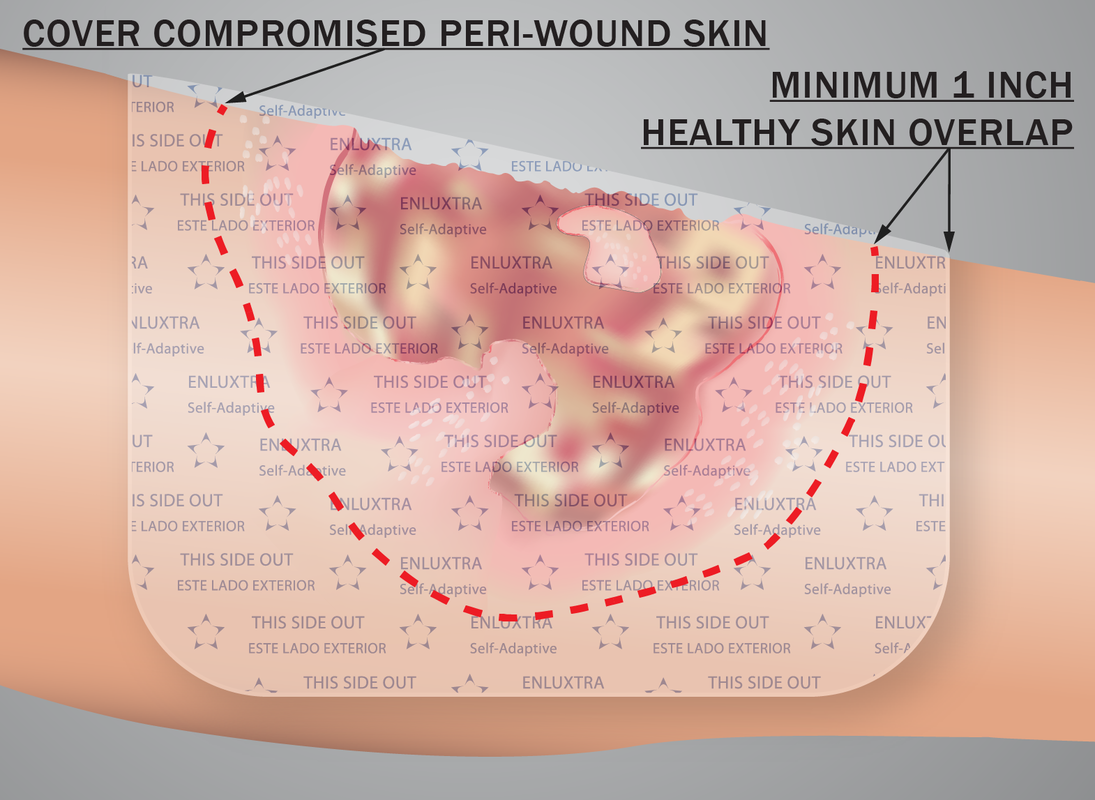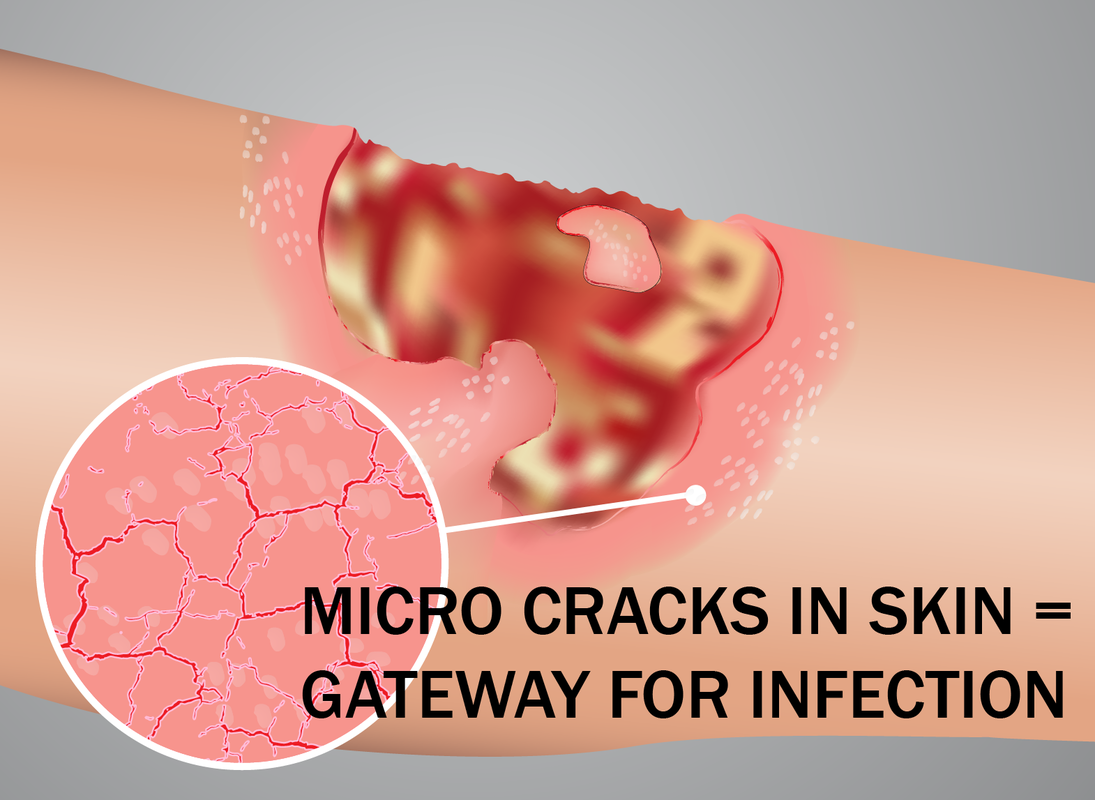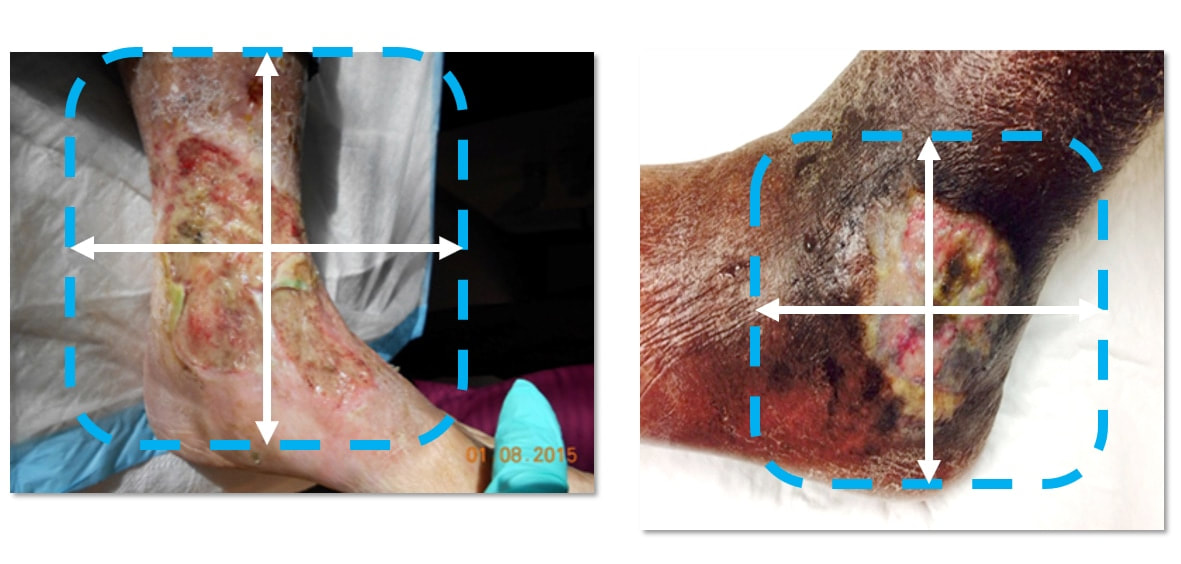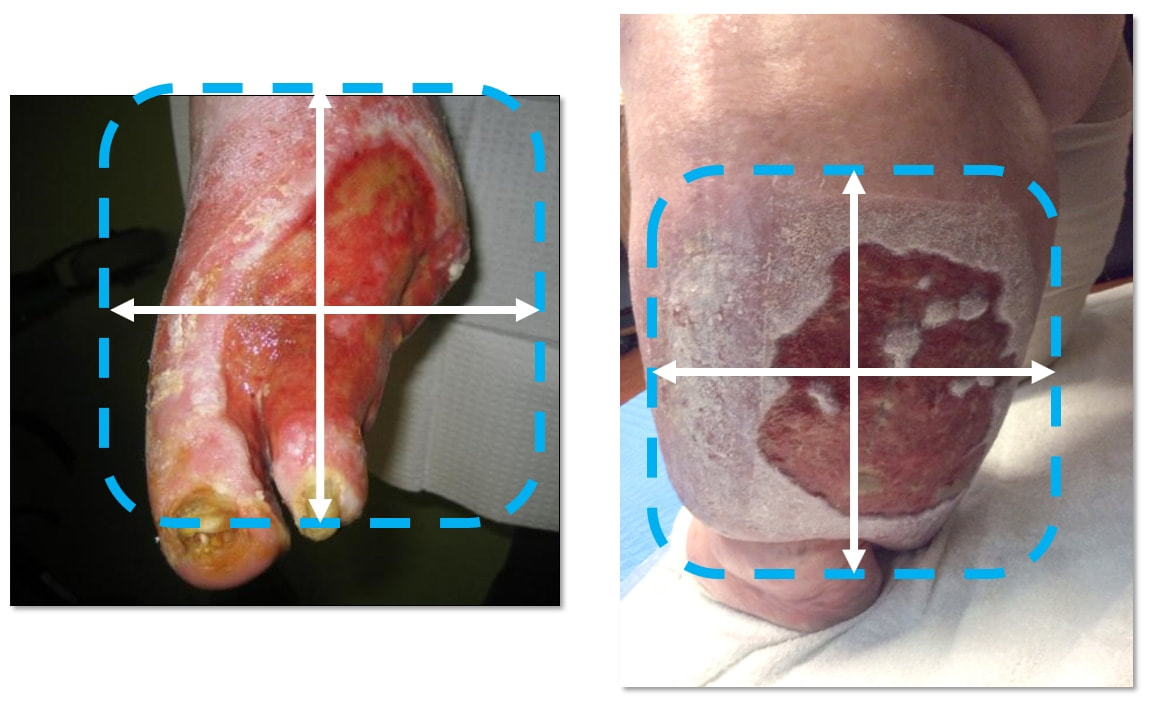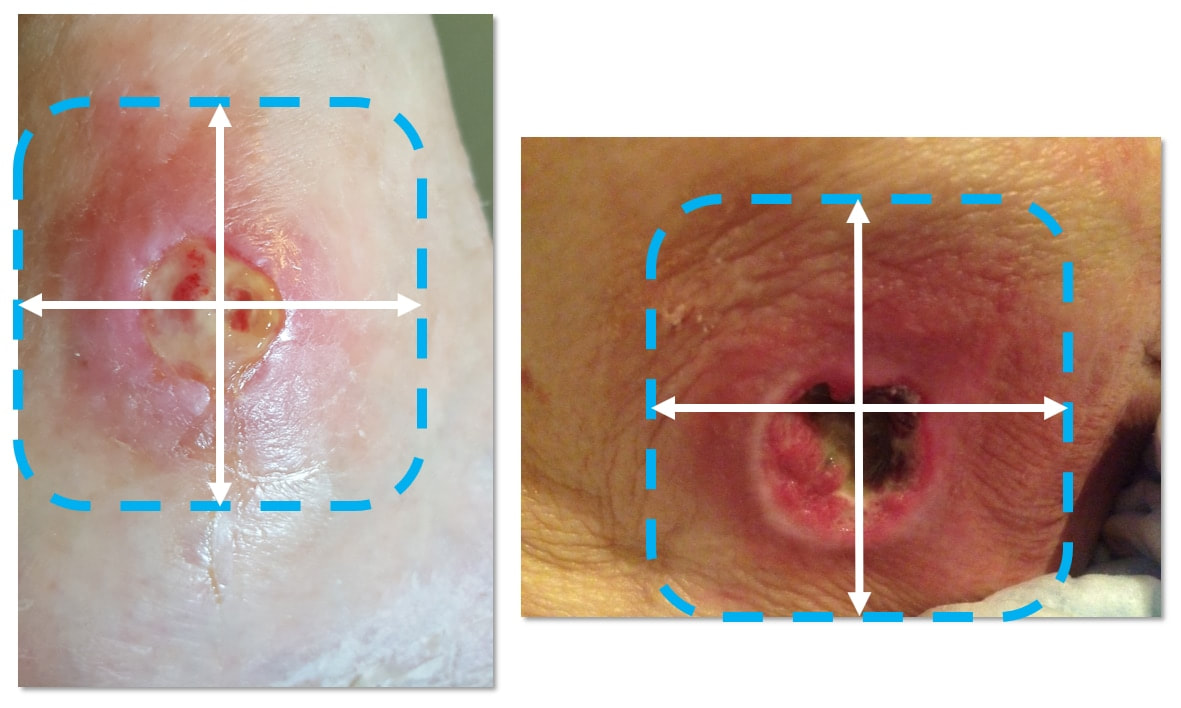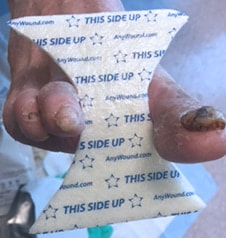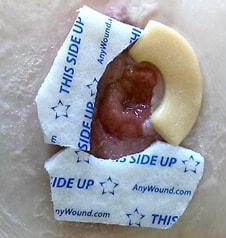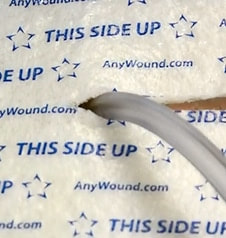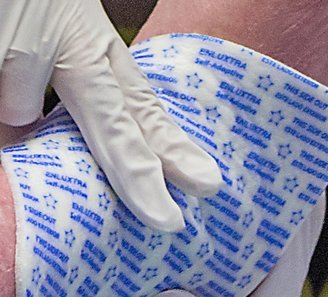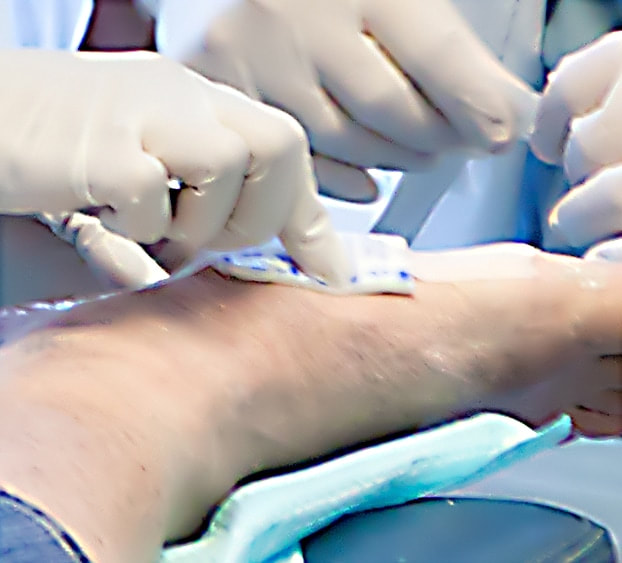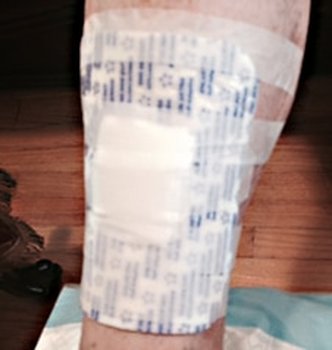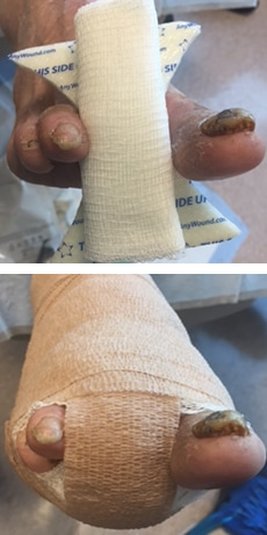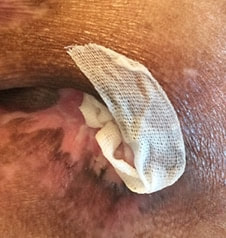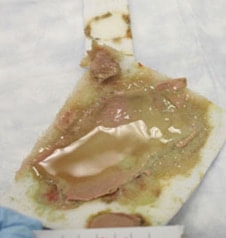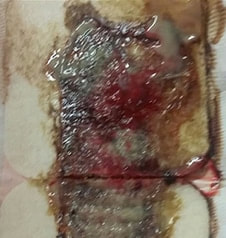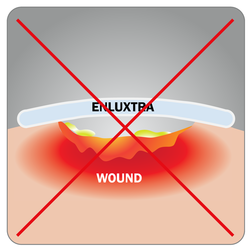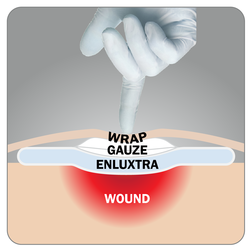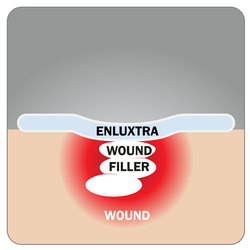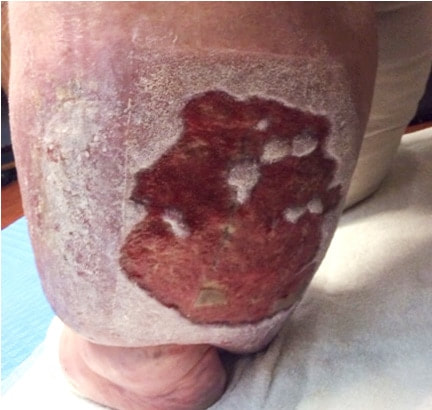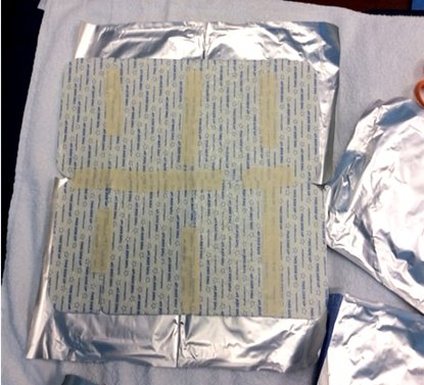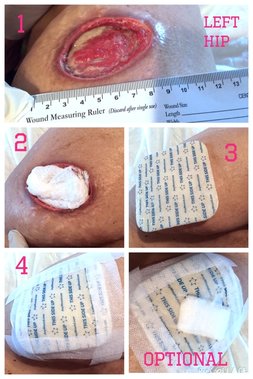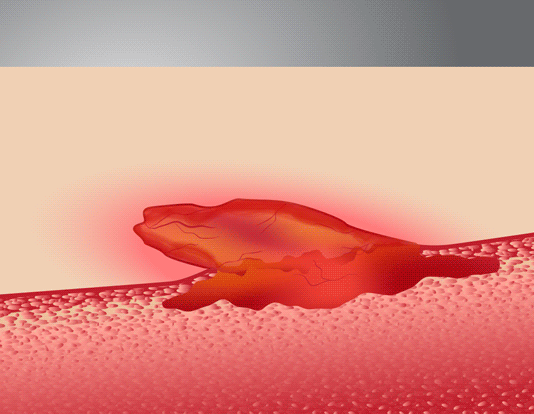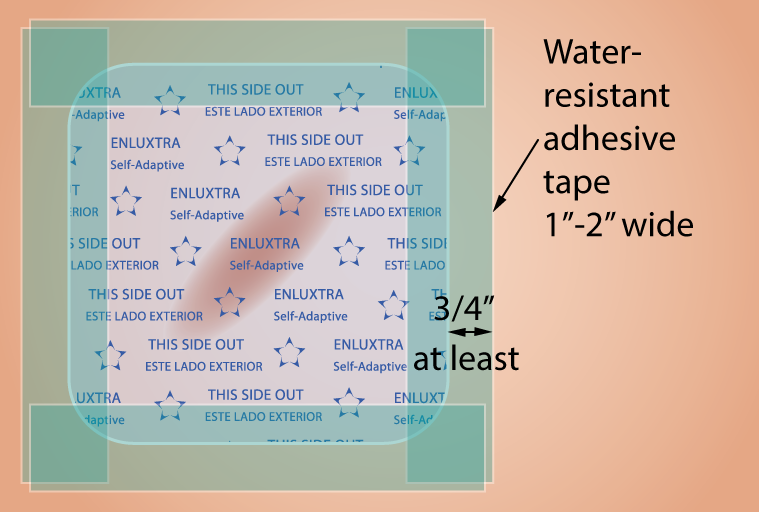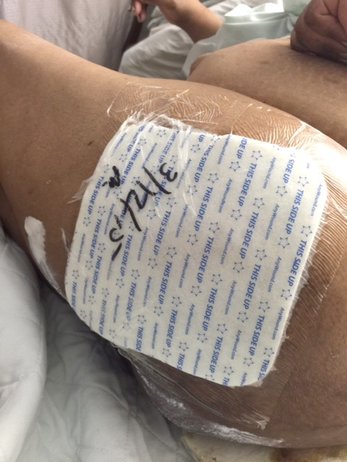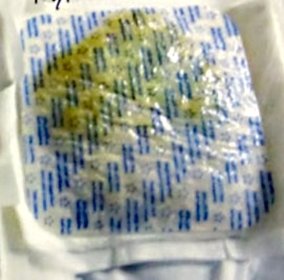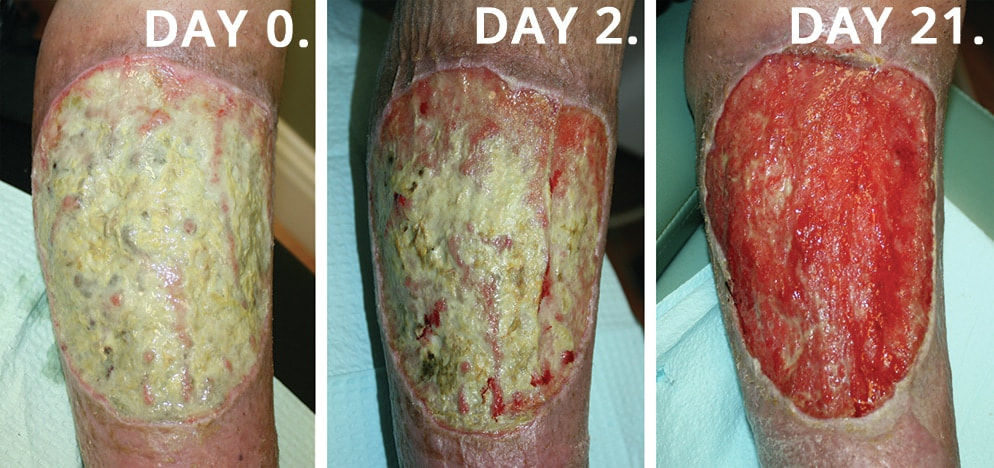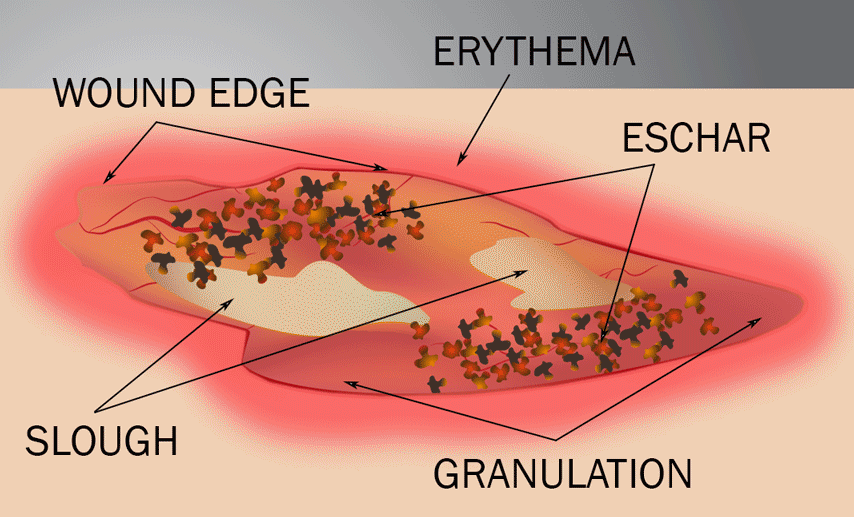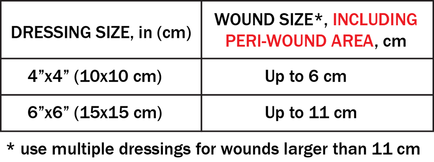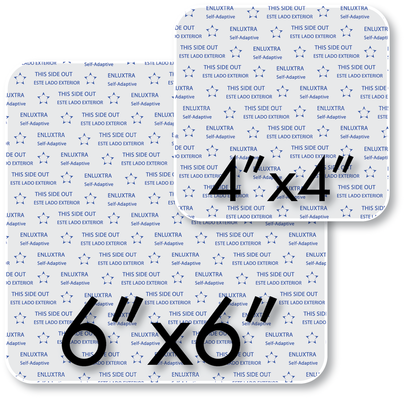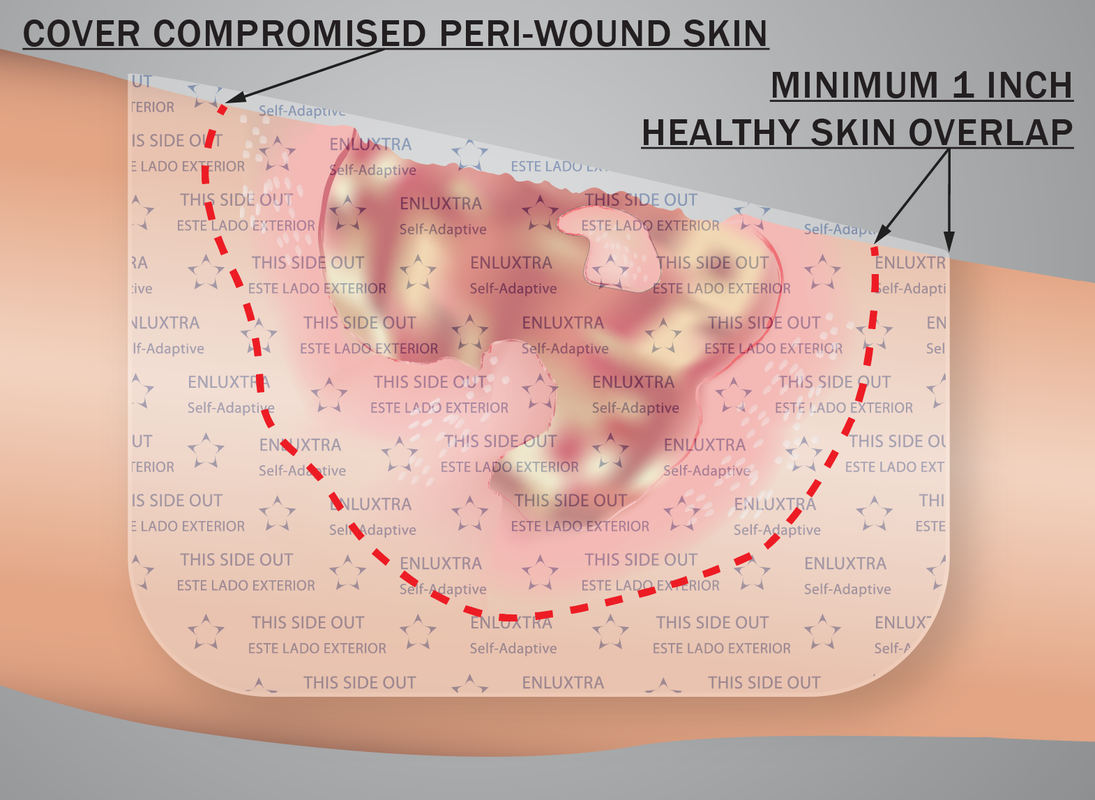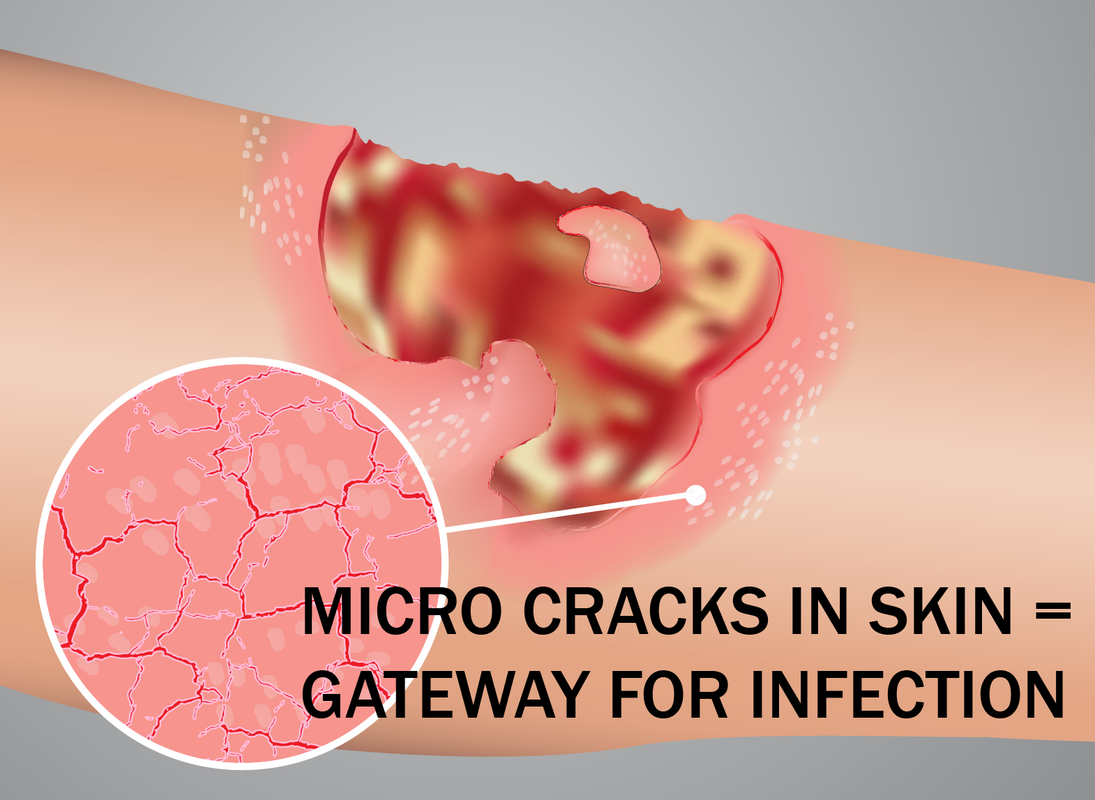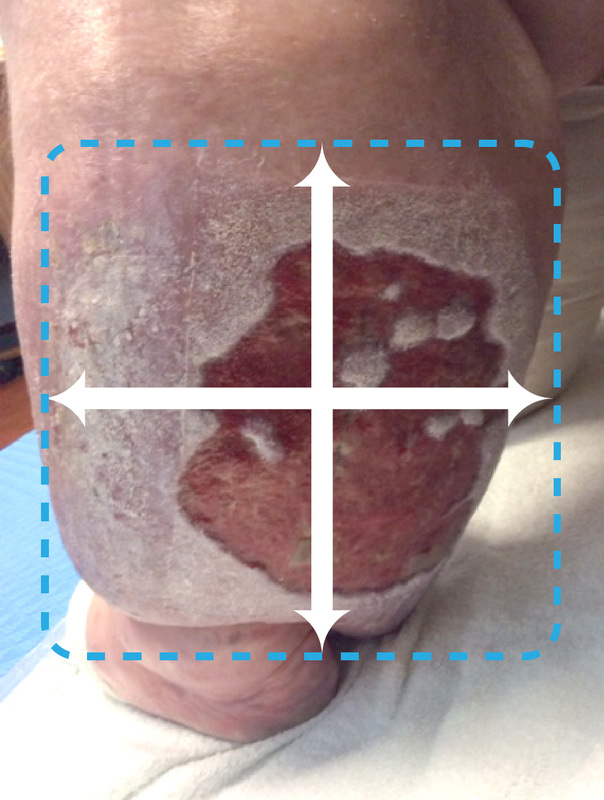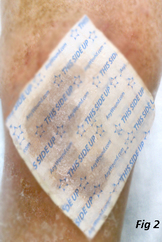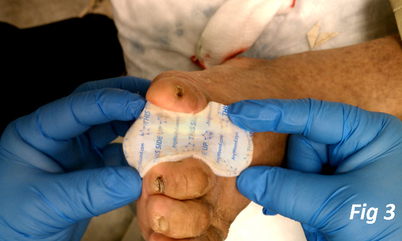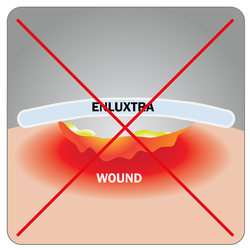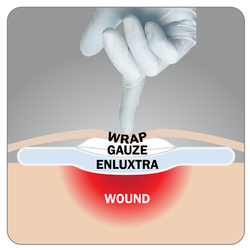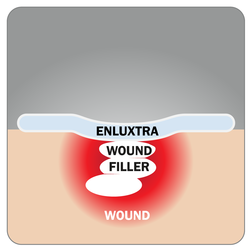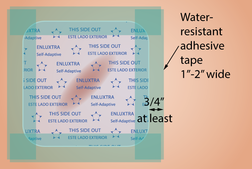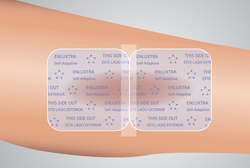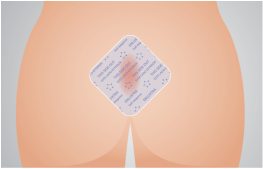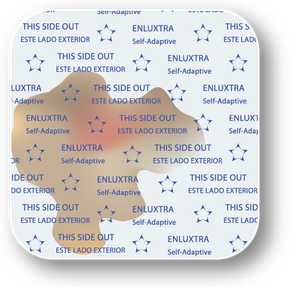HOW TO USE ENLUXTRA "ANY WOUND" SELF-ADAPTIVE WOUND DRESSING
READ THIS PAGE CAREFULLY
BEFORE USING ENLUXTRA SELF-ADAPTIVE DRESSING
or
critical rules to avoid the most common mistakes
WATCH THIS BEFORE USING ENLUXTRA!
WATCH THIS BEFORE USING ENLUXTRA!
INSTRUCTIONS FOR USE
The method for using the Self-Adaptive dressing is the same for ALL types of wounds.
|
STEP 1.
|
|
STEP 2.
|
Cleanse the wound with saline. DO NOT pat dry.
In case of minimally exuding/dry wound you may moisten the wound with saline or distilled water, OR apply amorphous hydrogel to wound bed area (or exposed tendons and bones). |
|
STEP 3.
|
Select the size of Enluxtra dressing that will cover the dimensions you recorded in STEP 1.
Use multiple dressings for large wounds. Do not cut Enluxtra to fit the wound size and shape. It is always better to have extra coverage. |
|
STEP 4.
|
Apply Enluxtra dressing onto the wound with the printed side facing out.
|
|
STEP 5.
|
Secure Enluxtra dressing with medical adhesive tape or a wrap. Do not overtighten.
|
APPLICATION TIPS
Click the topics below to learn more.
HOW TO SELECT THE CORRECT DRESSING SIZE
|
Selecting the correct size is a simple but THE MOST CRITICAL STEP.
IMPORTANT!!!
ALWAYS include inflamed/irritated peri-wound skin in total wound dimensions. For best results select the dressing size that will overlap HEALTHY skin by at least 1 inch. |
But how do you know if the peri-wound area is compromised?
Any of the following conditions are clear signs that protection is definitely needed:
Any of the following conditions are clear signs that protection is definitely needed:
- Dry, scaly skin
- Macerated skin
- Inflamed or irritated skin
What if a wound is too large for any size of Enluxtra? Read the topic "What if a wound is too large?" under Application Tips.
CAN ENLUXTRA BE CUT OR TRIMMED?
CHECK THAT ENLUXTRA STAYS IN CONTACT WITH THE WOUND BED
|
If you are not sure that the dressing is touching the deep wound bed, press it from outside with folded gauze pads and wrap over.
|
Use a wound filler for cavity or tunneling wounds. Drape 2 inches of wound filler across peri-wound to create a larger contact area.
Wound fillers you choose are important! We strongly discourage the use of alginates, honey products, or hydrofibers (e.g.Aquacel) with Enluxtra dressings. These products shrink with wound moisture and lose contact with the dressing surface. Use regular or impregnated gauze instead.
Here's an example of alginate used with Enluxtra. Not good! |
We do not recommend using thick and viscous pastes and ointments under Enluxtra dressing.
These products break the contact of the dressing surface with tissue and block vertical draw. As a result the dressing cannot absorb the exudate and maceration may develop. Here's an example of paste used under Enluxtra and resulting poor absorption. |
Here's a quick recap:
WHAT IF A WOUND IS TOO LARGE?
If the wound you are treating is large and cannot be properly covered with a 6"x6" Enluxtra dressing, you can combine multiple dressings by taping them together.
To cover this large wound a total of six 6"x6" Enluxtra dressings have been taped together:
To cover this large wound a total of six 6"x6" Enluxtra dressings have been taped together:
Watch a short tutorial that explains how to combine multiple Enluxtra dressings:
WHAT ABOUT TUNNELING, UNDERMINING AND OTHER COMPLICATIONS?
|
Read an excellent blog post where our Clinical Director Vicki Fischenich gives expert advice on treating complicated wounds with Enluxtra dressing.
Here are some of the wound filler products recommended for use with Enluxtra:
|
Additionally, check out these short video tutorials for more information:
INCONTINENCE AND SHOWERING
WHEN TO CHANGE ENLUXTRA DRESSING?
|
Change frequency strongly depends on the condition of the wound.
Initially you have to change Enluxtra dressings more often, especially if the wound is heavily draining and covered in slough. Change Enluxtra every 1-2 days at first. Once the drainage is under control and the wound bed is slough-free, you can gradually reduce change frequency. Eventually wear time can be extended to 7-10 days. Always change Enluxtra BEFORE the exudate reaches the dressing's edge. |
It is time to change this dressing!
|
HOW TO REMOVE SLOUGH?
ENLUXTRA is able to gradually remove wound slough and reduce odor.
Slough consists of solid and viscous components. Under Enluxtra dressing these components get liquefied by natural autolytic process and absorbed by the dressing along with the exudate fluid. The absorbed components are removed as the dressing is changed. Odor reduction follows concurrently. Typically the process takes 3-6 dressing changes to remove slough and odor completely.
Slough consists of solid and viscous components. Under Enluxtra dressing these components get liquefied by natural autolytic process and absorbed by the dressing along with the exudate fluid. The absorbed components are removed as the dressing is changed. Odor reduction follows concurrently. Typically the process takes 3-6 dressing changes to remove slough and odor completely.
During the slough removal process, change the dressing every 1-2 days to avoid dressing overload by the solid slough components. Follow these steps:
If a pre-existing infection is present, change the dressing more frequently until you see signs of improvement. Then reduce dressing change frequency.
- Rinse a wound with sterile saline before each dressing application.
- Change dressing every 1-2 days for the first 1-2 weeks or until slough and odor are removed.
- Then you may gradually increase wear time to 5-7 days until the wound is healed.
If a pre-existing infection is present, change the dressing more frequently until you see signs of improvement. Then reduce dressing change frequency.
TROUBLESHOOTING
If you encounter an issue when treating wounds with Enluxtra dressings, call clinical support 888-519-2297, or visit our Troubleshooting page where you can find help if any of the following problems arise:
- Maceration
- Slough build-up
- Wound not healing
- Foul odor
- Exudate leakage
- Hypergranulation
- Vascular wound bed
- Adverse reactions
STACKING ENLUXTRA FOR MAXIMUM ABSORPTION
For heavily draining wounds try stacking two or more Enluxtra dressings to increase absorption capacity.
Simply follow these steps:
1. Peel off and discard the printed backing film from the first Enluxtra dressing;
2. Place the second Enluxtra on top of the first “peeled” one;
3. Apply the dressing stack to the wound.
TIP: You can trim the resulting stack as needed for better fit in tight places.
Simply follow these steps:
1. Peel off and discard the printed backing film from the first Enluxtra dressing;
2. Place the second Enluxtra on top of the first “peeled” one;
3. Apply the dressing stack to the wound.
TIP: You can trim the resulting stack as needed for better fit in tight places.
IMPORTANT!!!
ALWAYS include inflamed/irritated peri-wound skin in total wound dimensions.
For best results select the dressing size that will overlap HEALTHY skin by at least 1 inch.
ALWAYS include inflamed/irritated peri-wound skin in total wound dimensions.
For best results select the dressing size that will overlap HEALTHY skin by at least 1 inch.
|
When applied to the wound, Enluxtra dressing MUST cover the compromised peri-wound skin and overlap healthy skin.
|
Still not sure about sizing? Watch a 1-minute tutorial:
- Select the appropriate size of Enluxtra Self-Adaptive Wound Dressing, allowing for at least a 1 inch skin overlap around the wound (the more overlap, the better, see Fig.1).
- Apply the dressing to the wound with the printed side facing out.
- If the wound is elongated, align the dressing so that it is placed diagonally along the longest central line of the wound.
- Allow for more skin overlap in the direction of the natural exudate flow to help the dressing trap and lock in the flowing exudate. See the picture below (Fig.2), which depicts a case when exudate is spreading down.
- It is not recommended to cut Enluxtra to the size of the wound. The more healthy skin around the wound is protected by the dressing, the better.
- However, you may trim the dressing if its edges interfere with nearby body parts (Fig.3).
NOTE: Trimmed dressing performance is not guaranteed for exuding wounds: the dressing may have to be changed more often.
IMPORTANT!
- Make sure that the dressing is in contact with the wound bed. If you are not sure that the dressing is touching the deep wound bed (see Fig.4), press it from outside with folded gauze pads and wrap over (see Fig.5), or use a wound filler for cavity or tunneling wounds (see Fig.6).
|
Recommended wound fillers:
|
|
|
|
RECOMMENDED DRESSING CHANGE FREQUENCY
ATTENTION! MUST READ BEFORE USING ENLUXTRA!
When you start ENLUXTRA on a new wound, always follow these steps:
- Assess wound conditions. If slough is present, use the Slough Removal Protocol (see below).
- Apply the appropriately sized ENLUXTRA dressing onto the wound allowing at least ¾ inch of dressing margin/overlap onto the HEALTHY skin or at least 1 inch for high drainage.
- Keep the first dressing on the wound for 2-3 days.
- Remove the dressing, assess the wound conditions. If the wound conditions are improving, apply a new ENLUXTRA dressing. You may start reducing the frequency of dressing changes gradually to once a week or even once per 10 days as the wound heals.
- If wound conditions are NOT improving and any of the following symptoms are present:
- leakage from under the dressing edge -- use larger size of Enluxtra;
- foul odor -- check if the dressing stays in good contact with the wound bed;
- buildup of slough -- check if the dressing stays in good contact with the wound bed;
- worsened peri-wound skin and wound edge -- use larger size of Enluxtra. Do NOT use skin preps with Enluxtra.
Also it is possible that pre-existing infection could be present and should be addressed. The dressing has to be changed more frequently until you see signs of improvement. Then you can start reducing the dressing change frequency.
- If the drainage is controlled and the wound has healthy granulation with leveled edges but appears to be not healing, this indicates that:
- the wound may need offloading
- underlying conditions have to be addressed
- patient is not compliant
- other factors exist that are unrelated to the dressing.
For more information contact us with your questions at: [email protected]
or call (888) 519-2297 ext.7 for clinical support
SLOUGH REMOVAL PROTOCOL:
ENLUXTRA is able to gradually remove wound slough and reduce odor.
Slough consists of solid and viscous components. Under Enluxtra dressing these components get liquefied by natural autolytic process and absorbed by the dressing along with the exudate fluid. The absorbed components are removed as the dressing is changed. Odor reduction follows concurrently. Typically the process takes 3-6 dressing changes to remove slough and odor completely.
During the slough removal process, change the dressing every 1-2 days to avoid dressing overload by the solid slough components. Follow these steps:
- Rinse a wound with sterile saline before each dressing application.
- Change dressing every 1-2 days for the first 1-2 weeks or until slough and odor are 80% removed.
- Then you may gradually increase wear time to 5-7 days until the wound is healed.
ENLUXTRA Virtual In-Service Video
|
|
|
|
CHANGING SELF-ADAPTIVE DRESSINGS
1. Select the appropriate size of Self-Adaptive Wound Dressing, allowing for adequate skin overlap (not less than 2cm or 3/4”).
2. Wash your hands with warm water and soap and put on gloves if ordered by your healthcare practitioner.
3. Carefully remove the soiled dressing and discard.
4. Clean the wound according to your healthcare practitioner’s instructions and discard cleaning materials.
5. If ordered by your healthcare practitioner, take off the gloves, discard them, wash your hands using warm water and soap, and put on clean gloves.
6. If prescribed, apply ointments to the wound.
7. Peel open the Self-Adaptive Wound Dressing pouch and remove the dressing, touching only the edges.
8. Apply the dressing with the printed side facing out from the wound. Allow for more dressing overlap in the direction of the natural exudate flow.
9. Secure the dressing in place as instructed by your healthcare practitioner.
10. Discard all soiled products.
11. Take off the gloves and discard them, then wash your hands with warm water and soap.
2. Wash your hands with warm water and soap and put on gloves if ordered by your healthcare practitioner.
3. Carefully remove the soiled dressing and discard.
4. Clean the wound according to your healthcare practitioner’s instructions and discard cleaning materials.
5. If ordered by your healthcare practitioner, take off the gloves, discard them, wash your hands using warm water and soap, and put on clean gloves.
6. If prescribed, apply ointments to the wound.
7. Peel open the Self-Adaptive Wound Dressing pouch and remove the dressing, touching only the edges.
8. Apply the dressing with the printed side facing out from the wound. Allow for more dressing overlap in the direction of the natural exudate flow.
9. Secure the dressing in place as instructed by your healthcare practitioner.
10. Discard all soiled products.
11. Take off the gloves and discard them, then wash your hands with warm water and soap.
CONTRAINDICATIONS
- Known sensitivity
- Heavy arterial bleeding
PRECAUTIONS AND WARNINGS
- Sterile unless damaged or opened
- Single-use
- Store at temperatures below 100°F
CONSULT A CLINICIAN
If you notice any of following:
- Excessive drainage or change in color
- Redness or warmth around the wound
- Pain or tenderness
- Unusual odor


